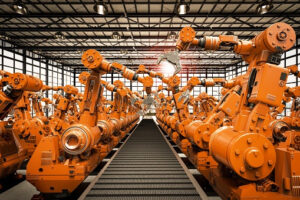

Zoe Stratos | Staff Columnist
U.S. unemployment has been an ongoing problem for years as manufacturers decide whether to outsource or automate their factories or to keep their workers in the ever growing and competitive world of business.
In recent interviews with President Trump, he has voiced the dangers of outsourcing jobs but has largely ignored automation as a whole. Certainly, outsourcing is a huge problem in the U.S. and undoubtedly limits job opportunities for workers. Nonetheless, the U.S. is still a manufacturing powerhouse in the world despite our high rate of industrial outsourcing.
As far as automation goes, it seemingly acts as an inside counterpart to outsourcing. In a study done by Mark Muro of the Brookings Institution in 2016, the U.S. manufactures twice as many products as 1984, but with one third fewer workers. This has caused public distress as many people believe a mechanical apocalypse is in the near future.
With that said, automation is not an entirely new threat — or a threat at all — to the U.S. Mass unemployment from automation is highly unlikely. Back during the Industrial Revolution, automation became commonplace through the introduction of the assembly line, standardization of parts and mass production. It created factory jobs in newly developing cities and made jobs more efficient and, in some cases, safer.
Moreover, automation allows for the creation of new jobs and expansion of current jobs. With inventions like self checkout scanners, grocery store clerks are able to focus more on stocking and other aspects of customer service without constant multitasking.
Similarly, ATMs allow tellers to focus on tasks other than transactions. When ATMs were introduced in the 1980s, bank tellers feared the mechanical takeover of their jobs by ATMs; however, U.S. bank teller employment rose steadily from 1980 to 2010.
People are worried because they are focusing on the unknown factor of whether or not they will lose their jobs rather than how their jobs could be improved. While the immediate problem of automation can cause unemployment or wage loss, in the long run it will prove beneficial as proven in the past.
In the U.S., however, studies of the phenomenon of machine helping man are hard to find. In a study done by economists James Bessen, Maarten Goos, Anna Salomons and Wiljan Van den Berge, investigators studied the long- and short-term effects of automation in the Netherlands. They analyzed around 5 million workers and their experiences with automation, as well as examining wages and unemployment insurance from 2000 to 2016.
The report finds that “firm-level automation increases the probability of workers separating from their employers and decreases days worked, leading to a 5-year cumulative wage income loss of 11% of one year’s earnings.”
However, as it is, the Netherlands were able to slightly balance this loss with state benefits. This proves, then, that automation is a slow-moving force rather than a mechanical apocalypse; mass unemployment is highly unlikely.
This means the automation process is more individually based, and the government has taken no steps to allot for those damaged by it. As mentioned before, Trump has solely focused on outsourcing as a major unemployment problem rather than taking a grassroots approach to problems within the country. This focus on trampling outsourcing in turn will cause big business to automate and cut jobs, and no government benefits will help these people in the immediate future.
Ultimately, automation comes with major future advantages but with immediate problems; the only way to prevent these problems is to mandate government benefits and creation of more immediate job opportunities. It is time for the government to focus more within the scope of our country, rather than what is outside.
